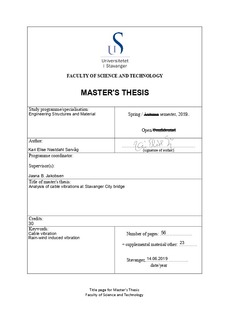| dc.contributor.advisor | Jakobsen, Jasna B. | |
| dc.contributor.author | Sørvåg, Kari Elise | |
| dc.date.accessioned | 2019-10-09T11:05:27Z | |
| dc.date.available | 2019-10-09T11:05:27Z | |
| dc.date.issued | 2019-06-14 | |
| dc.identifier.uri | http://hdl.handle.net/11250/2621152 | |
| dc.description | Master's thesis in Structural Engineering | nb_NO |
| dc.description.abstract | After the opening of the cable-stayed bridge Stavanger City Bridge in 1978 there have been reports of vibrations of the stay cables. The bridge is 1066,6 m long, and has a main span of 185 m. The main span is supported by a pylon and 3 stay cable bundles on each side. The individual stay cables are interconnected by crossties to reduce vibrations.
Wind loads are known to induce various types of vibrations of structures. Flexible structural elements such as stay cables are especially prone to aerodynamic instabilities. A large amount of these vibrations is known to be rain-wind induced vibrations. This thesis will focus on the possibility of the vibrations at the Stavanger City Bridge being rain-wind induced vibrations.
The thesis has analysed the weather conditions at the time of observed vibrations, in order to evaluate the possibility of rain-wind induced vibrations at Stavanger City Bridge. There has also been an estimation of the number of hours the bridge may have been subjected to vibrations due to the combined action of rain and wind loads by analysing hourly weather data from eKlima.met.no.
The inherent parameters of the bridge are estimated based on six ten-minute periods of recorded accelerations at the bridge using MATLAB. The acceleration response of three cables and the bridge deck was analysed. Based on the recorded data an attempt to identify the first frequency mode of the cables and the bridge deck was performed by analysing the power spectral density. The damping ratio was estimated, and the identified frequencies were also compared to an estimation of frequencies of two of the stay cables. There was some difference in the estimated frequencies and the identified frequencies, most likely due to an oversimplification in the calculations of the estimated frequency.
The thesis found that for four of the five observed instances of vibrations it is reasonable to assume that vibrations could be rain-wind induced vibrations. The vibrations could also be due to other phenomena, e.g. wake effects from the pylon or the adjacent individual cables. | nb_NO |
| dc.language.iso | eng | nb_NO |
| dc.publisher | University of Stavanger, Norway | nb_NO |
| dc.relation.ispartofseries | Masteroppgave/UIS-TN-IMBM/2019; | |
| dc.subject | byggkonstruksjoner | nb_NO |
| dc.subject | materialteknologi | nb_NO |
| dc.subject | cable vibrations | nb_NO |
| dc.subject | cable-stayed bridge | nb_NO |
| dc.subject | konstruksjonsteknikk | nb_NO |
| dc.subject | rain-wind induced vibrations | nb_NO |
| dc.title | Analysis of cable vibrations at Stavanger City bridge | nb_NO |
| dc.type | Master thesis | nb_NO |
| dc.subject.nsi | VDP::Technology: 500::Building technology: 530::Construction technology: 533 | nb_NO |
